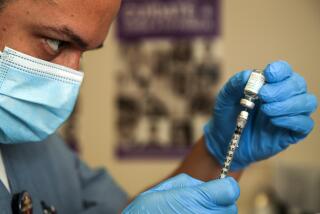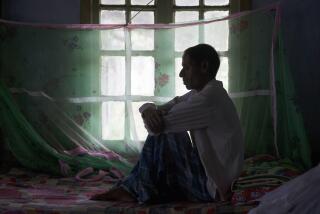AIDS Cases in County Continue Steady Rise
- Share via
About 100 Los Angeles County residents have been diagnosed with AIDS in each of the last three months, part of a “slow and steady” increase in cases of the deadly disease that county health officials expect to continue for at least several years.
The county Department of Health Services confirmed 103 new AIDS cases in May, bringing the number of cases since the beginning of the epidemic to 1,852, according to statistics released Thursday. A total of 15,000 to 20,000 AIDS cases are projected in the county by 1991.
The county counted 122 AIDS cases in March and 98 in April, compared to an average of about 65 cases a month during the preceding six months.
“We are seeing what we expected,” said Dr. Martin Finn, medical director of the department’s AIDS program.
“This is not exponential growth but a slow and steady increase in cases. The statistics are alarming because people have not realized what they mean in terms of human pathology and medical costs.”
Finn “conservatively estimated” that 150,000 county residents are already infected with the virus that causes acquired immune deficiency syndrome. It is transmitted through the blood or by sexual contact.
An additional 110 reports of possible cases are being investigated, a backlog that has been relatively constant for several months and is not believed to be a factor in the increased number of cases.
In excess of 90% of the new AIDS victims, as in previous months, are homosexual or bisexual men, although health officials anticipate that more cases will develop in intravenous drug users and heterosexuals in future years. Strikingly, about 50% of AIDS cases on the East Coast develop in drug users, compared to less than 5% of AIDS cases on the West Coast.
The statistics reflect increased exposure to the AIDS virus in the Los Angeles homosexual community in the early 1980s, according to Dr. Donald Lyman, chief of the state Department of Health Service’s AIDS office.
This was before the extent of the epidemic was recognized and before most homosexuals began taking precautions to halt the spread of the disease. There is a lag time of at least two to four years between an individual’s infection with the virus and the development of AIDS or related diseases. It is not known what percentage of those infected with the virus will eventually develop AIDS.
Lyman said health officials will have to wait until at least sometime next year to see if so-called safe-sex precautions, such as monogamy and the use of condoms, will have any effect in limiting the epidemic.
By comparison, the rate of increase in AIDS cases in the San Francisco area, where the disease began to spread earlier, is beginning to decline, but the number of new cases is still rising, according to Dr. Dean Echenberg, director of disease control for the city’s Department of Public Health. About 50% of the homosexual males in the city are estimated to have been infected with the AIDS virus.
As of June 1, there had been 2,042 AIDS cases in San Francisco, according to Echenberg. This included 101 cases in February, 74 in March, 90 in April and 83 in May, compared to an average of 60 to 69 cases a month in the previous year.
Throughout the country, 21,302 people had developed AIDS as of June 1, and 11,645 had died. By 1991, the number of cases nationally is expected to exceed 270,000, with more than 175,000 deaths, according to federal officials.
Of the Los Angeles victims, 1,699 are homosexual or bisexual men, 46 are heterosexual intravenous drug users, 40 are hemophiliacs or blood transfusion recipients, and 13 are heterosexual partners of a person with AIDS or the AIDS virus. There were 13 cases in children and 41 unclassified cases. Of the victims, 71% are white, 14% Latino and 14% black. A total of 1,030 AIDS victims have died.
AIDS is an invariably fatal viral disease that attacks the body’s immune system, leaving the victim vulnerable to a variety of tumors and infections. To avoid confusion caused by multiple names, the AIDS virus was recently renamed HIV or “human immunodeficiency virus” by an international panel of scientists.
More to Read
Sign up for Essential California
The most important California stories and recommendations in your inbox every morning.
You may occasionally receive promotional content from the Los Angeles Times.













